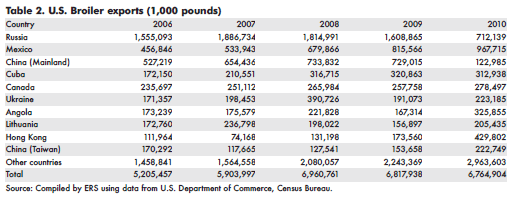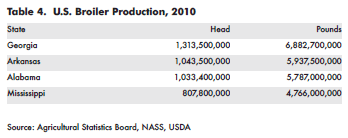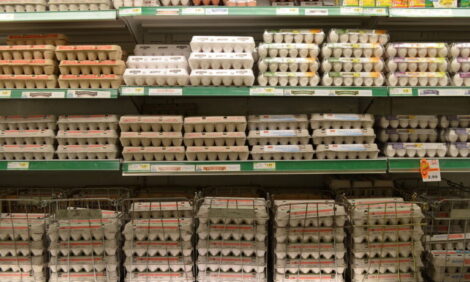



The Mississippi Poultry Industry and its Economic Impact
An overview of the broiler and egg industries in the state, which ranks number 4 in the country's poultry states, according to a report from Mississippi State University.Poultry Facts
- Mississippi’s poultry sector exceeded $2.4 billion in sales at the farm gate in 2010.
- Total sales of poultry products by Mississippi processors in 2010 exceeded $2.8 billion.
- Mississippi is home to Cal-Maine Foods, Inc., the largest egg processor in the world.
- Mississippi produced 757 million broilers in 2010, or 1,441 broilers per minute.
- A Mississippi chicken weighs between 3.8 and 8.5 pounds when slaughtered, depending on the target market.
- Chicken feed is 60 per cent corn and 18 per cent soybean meal.
- Mississippi chickens ate nine billion pounds of feed in 2010.
- In 2010, 97 million bushels of corn were raised in Mississippi. Mississippi broilers consumed more than 89 million bushels of corn in 2010.
- Mexico replaced Russia as the largest purchaser of US poultry, with more than 967 million pounds shipped in 2010. The poultry export market is especially important for Mississippi because poultry is often shipped out of ports in the South.
- Mississippi 2010 poultry exports were valued at more than $314 million, or 11.2 per cent of total sales.
- The poultry industry in Mississippi employs more than 28,000 people directly and another 27,000 indirectly. In other words, the industry helps create more than 55,000 jobs.
- Wages and salaries paid to poultry employees in Mississippi exceed $1.19 billion. The poultry industry is responsible for creating approximately $960 million more in payrolls for other industries, due to economic activity generated by the poultry industry. The total impact is more than $2.15 billion in wages and salaries paid.
- The total economic impact as a result of the Mississippi poultry industry is more than $2.9 billion value-added in 2010. (Value-added includes wages and salaries, indirect business taxes, and profits.)
Overview of the Industry
The combined value of production from
broiler, egg, turkey, and chicken sales in
2010 was $34.7 billion, up 10 per cent from
$31.6 billion in 2009. Of that total, 68 per cent
was from broilers, 19 per cent from
eggs, 13 per cent from turkeys, and less
than one per cent from chickens. The US
poultry industry continues to be a major
supplier of protein in the United States
and the world.
The US poultry industry serves many
markets. The first major market separation
is between the domestic market and the
export market. The American market
prefers white meat, leaving most of the
dark meat for export. The export market is
affected by conditions such as oil prices,
wars, natural disasters, currency fluctuations,
political issues and other
worldwide problems that are beyond the
control of the poultry integrator.
The US market is further segmented
into chicken for consumption at home and
chicken for consumption in restaurants,
schools and other institutions. Most of the white meat is further processed. Away-from-home
meals and snacks captured 48 per cent of the US food
dollar in 2010.
Poultry integrators must provide products
processed specifically for each market segment. In
the domestic market, prices are largely a function of
input prices, other competing meat prices, and the status
of the US economy. The past several years have
been difficult for the industry due to high prices for
both corn and soybean meal and a very slow-growing
economy. Despite these challenges, poultry remains a
good value for the consumer. Figure 1 shows the relationship
between average retail prices paid for beef,
pork, and poultry products since 2005. Poultry retail
prices have remained almost constant while beef and
pork prices have steadily increased.

In the United States, per-capita consumption of broiler products continues to be more than consumption of beef and pork, its two main competitors. In 2010, the per-capita consumption of total broiler products reached 82.3 pounds. Per-capita consumption for broilers, beef and pork in the US totalled 189.6 pounds. Broilers constituted 43 per cent of the top three meats consumed in the domestic market in 2010. Table 1 compares per-capita consumption of broilers, beef and pork from 2000 to 2010.
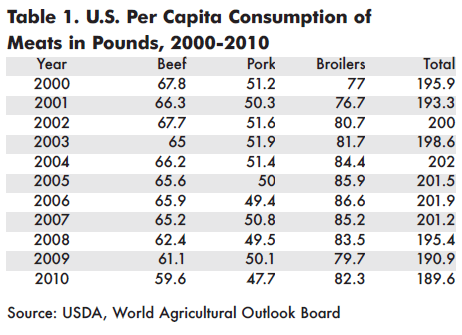
Export Trade
The rapidly growing world population will be consuming
two-thirds more animal protein by 2050 than it
does today, according to World Livestock 2011, a study
conducted by the United Nations’ Food and
Agriculture Organization (FAO). Growing populations
and incomes are fuelling the trend toward increased
consumption of animal protein in developing countries
worldwide. This increased consumption is
helping to keep US poultry exports expanding.
Broiler meat shipped in October 2011 totalled 689.7 million
pounds. That was a 2.5 per cent increase from the
same period in 2010, despite the fact that October 2010
shipments were the highest monthly volume recorded
that year.
There are several notable differences in trade flows
between 2011 and 2010. Shipments to Russia in
October 2010 totalled 211 million pounds, which
accounted for 31.5 per cent of the US broiler exports
for that month. In October 2011, Russia banned US
poultry imports, thus reducing imports to only 64.4
million pounds, a reduction of about 69.5 per cent.
However, other markets more than made up the
decrease caused by Russia’s ban. For example, broiler
shipments to Hong Kong totalled 55.7 million pounds
in October 2011, a 45 per cent increase from the previous
October. In October 2010, shipments to Angola
totaled only 14.4 million pounds. However, one year
later, these shipments rose to 60.5 million pounds, a
320 per cent increase. Secondary markets also imported
more broiler meat in October 2011, offsetting the
decreased shipments to Russia. Several regions,
including Mexico, Cuba, Hong Kong, Angola, Japan,
United Arab Emirates and China, imported more
broiler meat from the United States than in 2011 than
they did in 2010. Mexico, the top US broiler destination
for 2011, imported almost 4 million pounds more
in September 2011, while Hong Kong imported almost
30 million pounds more than it did the year before1.
The following table shows US broiler exports over
the last five years.
History of Mississippi Poultry Industry
During the early part of this century, there was great
interest in poultry breeds. Birds were selected and
bred to produce a pure breed that would place high in
poultry exhibitions. Breed purity was more important
than performance. Poultry judges were prestigious
and influential.
Some of the more popular breeds were
Wyandotts, Dominiques, Orpingtons, Plymouth Rocks,
Rhode Island Reds and Leghorns. There were many
plumage and colour variations within most breeds.
The poultry industry began to mature during the late
1920s, when commercial poultry operators began
cross breeding to improve bird productivity. Bird
fanciers were horrified. They suggested that breeders who crossed breeds were admitting that they did not
have the ability or patience to succeed in the purebred
world. Some hold this view today, despite the fact that
all scientific research shows that cross–breeding is a
wise choice.
It was common in the 1920s through the 1940s for
hatcheries to be located on or near the main streets of
many Mississippi towns. Chicks were usually sold
over the counter in small quantities. Most orders were
for 10 to 50 chicks.
In the late 1920s, the State Poultry Federation
served the poultry industry in Mississippi. There were
more than 2,500 members in about 35 county associations
and one area association, the Delta Poultry
Federation. The Delta Poultry Federation had its annual
poultry show at Indianola. In the 1930s, the
Mississippi Hatchery Association and the Mississippi
Poultry Federation combined to form the Mississippi
Poultry Producers Association (MPPA), which eventually
developed into today’s Mississippi Poultry
Association (MPA).
The US Department of Agriculture (USDA)
launched the National Poultry Improvement Plan
(NPIP) in 1935 to control pullorum disease, commonly
called bacillary white diarrhoea. Significant progress
was made during the early 1940s to control the disease.
The percentage of pullorum reactors permitted in a
flock was reduced from 10 per cent in 1940 to less than
five per cent in 1945. Today, Mississippi is designated as a
Pullorum-Clean state. The disease has been eradicated
from commercial poultry flocks in the state.
The US poultry industry grew significantly during
the years of World War II. This growth, however,
did not greatly impact the developing Mississippi
poultry industry until the late 1940s and early 1950s.
During this period, more and more poultry companies
began purchasing their own breeder flocks,
hatcheries, feed mills, grow-out operations and processing
plants. This type of operation was called a
‘vertically integrated operation’. The advantages of
vertically integrated operations include reduced costs on volume purchases, formation of a single profit
point (at the sale of the bird), implementation of the
latest technical information available, better record
keeping and improved processing and marketing procedures.
By the mid-1950s, integrated poultry companies
began contracting with farmers to produce eggs and
broilers. In general, the contract agreement required
the company to provide chickens, feed and technical
knowledge. The farmer provided the land, house,
equipment and labour. The vast majority of
Mississippi’s broilers and eggs are still produced
under this type of contract arrangement.
The Extension Service and the Mississippi Poultry
Improvement Association conducted numerous poultry
barbecue demonstrations throughout the state to
promote increased poultry consumption. Poultry companies
hired men to work with the farmers with
whom they had production contracts. These men were
called ‘servicemen’. Mississippi State University conducted
schools to teach the most current technology
available. Approximately 150 to 300 poultry workers
attended the two-day schools.
The industry matured during the 60s and early
70s. Several companies ceased to operate efficiently
and were purchased by other companies. The industry
consolidated into fewer, larger companies2.
Poultry Integrators Operating in Mississippi
Koch Foods
Koch Foods began in the early 1970s. Its corporate office is located in Chicago. The company is owned by Joseph Grendys. In 2001, Koch Foods purchased B.C. Rogers, which was headquartered in Morton, Mississippi. Additional operations are located in Illinois, Ohio, Tennessee, Alabama and Georgia. Koch Foods has 2,700 employees and 650 growers in Mississippi.
Marshall Durbin Company
Marshall Durbin, Sr., began his business by selling fish
and chicken in downtown Birmingham, Alabama. In
1930, he expanded into Mississippi when a bulk feed
station was built in State Line. After the death of his
father, Marshall Durbin, Jr., took over leadership of the
company and in 1973 acquired four Mississippi poultry
firms.
The poultry company became one of the first
in the nation to establish a science and technology centre.
Located in Jackson, the lab was dedicated to
product safety and consumer health and was a significant
investment for the company. In 1978, Marshall
Durbin, Jr., was inducted into the Alabama Poultry
Hall of Fame, and the company built a new feed mill,
hatchery, and fleet garage in Philadelphia, Mississippi.
Durbin completed a new laboratory in Jackson and
finished remodelling a rendering plant in Hattiesburg
in 1979. He was inducted in the Mississippi Poultry
Hall of Fame in 1989. He died in 2001, and his daughters,
Melissa and Elise Durbin, took control of the
company.
Peco Foods, Inc.
John Herman Hickman started what is now Peco
Foods in 1937, when he agreed to raise about 75 White
Leghorn chicks for a family member in Gordo,
Alabama. Soon, he was knocking on doors and selling
chickens to homemakers for Sunday dinners. He
obtained incubators and hatching machines, and in
1938, he began to vertically integrate his business.
In
late 1989, the Hickman family expanded into
Mississippi with the addition of the Bay Springs processing
plant and feed mill. Today, Peco Foods, Inc., is
the 10th-largest poultry company in the United States.
Sanderson Farms, Inc.
Sanderson Farms, Inc., a publicly held, vertically integrated
poultry company, has more than $1 billion in sales and operations in Mississippi,
Louisiana, Texas and Georgia. Sanderson Farms ranks
among the top five poultry producers in the country,
currently employing more than 8,800 people and contracting
with more than 600 independent growers.
The
company began as a farm supply business in 1947,
selling seed, feed, fertiliser and other farm supplies. In
1951, D.R. Sanderson, Sr., D.R. Sanderson, Jr. and Joe
Frank Sanderson organised a partnership named Sanderson Brothers. During the next few years, poultry
production was added to the business. Then, in
1955, Sanderson Farms was incorporated, and the
company began its growth into a top-quality chicken
producer, which today is publicly traded on the NASDAQ
exchange.
Tyson Foods, Inc.
Tyson Foods is owned and operated by the Tyson family.
Although headquartered in Springdale, Arkansas,
John Tyson began selling chickens outside Arkansas in
the 1930s. By purchasing incubators and building feed
mills, he moved toward vertical integration. From the
1930s until the 1990s, Tyson Foods continued to grow.
In 1995, Tyson Foods purchased McCarty Farms,
which was headquartered in Magee, and expanded the
company with the addition of large processing facilities
located in Forest and Carthage.
While it is still
owned and operated by Don Tyson and his son John
Tyson, Tyson Foods is a publicly traded company.
Wayne Farms, LLC
Wayne Farms is a division of ContiGroup Companies,
founded in Belgium in 1813 and one of the largest privately
held companies in the United States.
Wayne
Farms, LLC, has been doing business since 1965, when
it grew out of Allied Mills, a former subsidiary of
Continental Grain Company. Wayne Farms began with
locations in Albertville and Union Springs, Alabama.
Over the course of the past 30 years, the company has
acquired several processing facilities, including a new
plant in Laurel. The original facility in Laurel was constructed
in 1957 and later acquired by Wayne Farms.
The company now employs more than 1,000 workers
in Laurel. Local employment spans across Clark,
Covington, Forrest, Lamar, Jasper, Jones, Perry and
Smith counties in Mississippi and Choctaw County in
Alabama.
Wayne Farms is the fourth-largest vertically
integrated poultry processor in the United States with
annual sales exceeding $1 billion. Today, Wayne Farms
employs 9,250 people in eight integrated complexes,
including eight hatcheries, seven feed mills, eight
slaughter-processing plants, and five further-processing
plants.
Egg Production in Mississippi
The world’s largest company involved in producing,
cleaning, grading, packaging and selling fresh shell eggs established its corporate headquarters in Hinds
County, Mississippi, in 1963. At that time, the company
employed about 200 people. Today, Cal-Maine
Foods, Inc., employs more than 1,400 people and
maintains facilities in 15 states.
Under the leadership
of chairman and CEO Fred Adams, Jr., Cal-Maine has
experienced steady growth and now markets 683 million
dozen eggs per year. These eggs are produced by
some 23 million laying hens. Most of the hens are
Single Comb White Leghorns, the favourite breed for
production of table eggs in the US.
Cal-Maine is a
fully integrated producer and controls every aspect of
production, processing, and distribution in its modern
facilities, where the company carefully controls temperature,
lighting, and humidity. At its in-line
processing and distribution plants, Cal-Maine gathers,
cleans, grades and packages the eggs mechanically, so
no human hands touch them. On a normal day, the
company processes about 216,750 dozen eggs each
hour.
To ensure freshness and quality, Cal-Maine has a
large fleet of trucks that deliver eggs to customers in
29 states in the Southeast, Southwest, Midwest and
mid-Atlantic regions of the US Cal-Maine is a quality
Mississippi-based corporation and it is determined to
maintain its leadership position in the egg industry.
Mississippi Poultry Industry Size and National Rank
The poultry industry is the largest income-producing
agricultural commodity in Mississippi. In 2010, the
Mississippi poultry industry value of production
exceeded $2.4 billion. The poultry industry is
the top agricultural commodity in the state and has
been for the past 16 years.
The majority of the
Mississippi poultry industry’s income is generated by
broilers (92 per cent), with commercial egg production
(seven per cent) making up most of the remainder. Spent
hens and non-commercial farm chickens produced
about one per cent of the total poultry income.
Mississippi ranked fourth in the nation in 2010 based
on the number of broilers produced.
Typical farms now have four to six houses with 25,000
birds per house. Typically, one full-time worker can
manage three houses. A flock of chickens reaches market size in about six weeks, depending on the target
market. On average, a new broiler house is about 500
feet long by 44 feet wide and costs about $200,000
equipped. Broiler production is concentrated in central
Mississippi. In 2010, more than 1,400 farmers in 36
counties contracted with broiler integrators. The exact
number is hard to determine because some contract
farmers own many houses and hire family members or
other individuals to manage groups of houses. The following
table shows numbers of broilers produced by
county in Mississippi and the concentration of production
within the state.
Most broilers produced in Mississippi are
processed at one of the 19 in-state processing facilities.
Most birds are not sold as whole birds; they are further
processed. Fifteen of the processing facilities in
Mississippi are capable of further processing. Further
processing may mean the birds are cut up, deboned,
formed, marinated, breaded, cooked, or specially
packaged. Exact data on poultry processing sales, by
plant, are not accessible because many companies are
privately held businesses. However, according USDA
2010 annual estimated pounds slaughtered in
Mississippi and the USDA 2010 average wholesale
price per pound for processed chicken, the estimated
sales for processing is approximately $2.8 billion. Table
6 lists all the processing plant locations and type of
processing in Mississippi.
Economic Impact of the Mississippi Poultry Industry
The Mississippi poultry has a positive economic impact on many other businesses, both directly and indirectly. Many other industries benefit from the poultry industry in Mississippi. For example, small farmers who contract with integrators grow broilers in Mississippi. Corn and soybeans grown on Mississippi farms are major ingredients in broiler rations. Mississippi construction workers build broiler houses and processing plants. Mississippi facilities process broilers. Transportation companies ship poultry products both domestically and for export. Equipment manufacturers supply production and processing machinery, paper and plastic manufacturers supply packaging, and financial services help provide capital for investments and operating expenses.
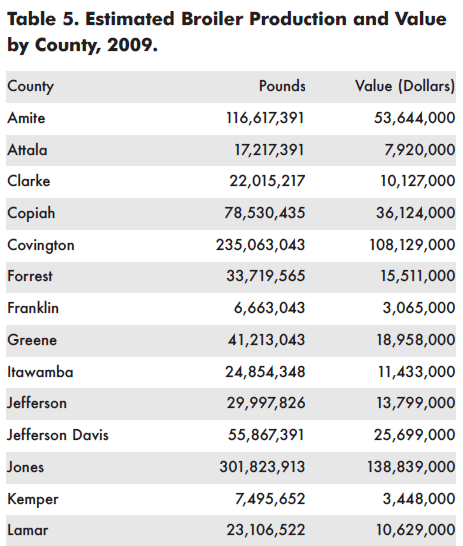
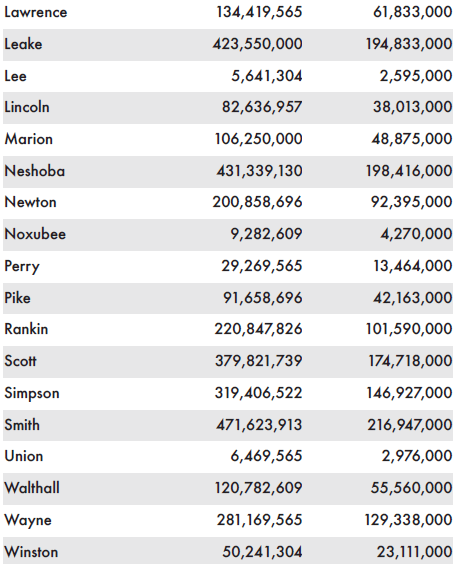

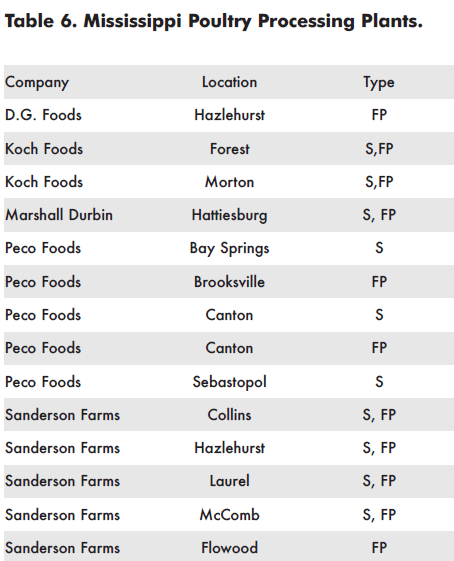
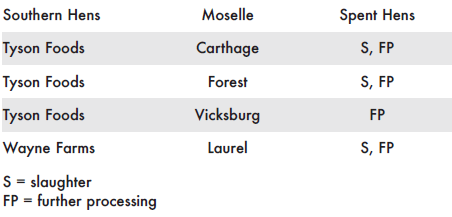
The poultry industry has a significant direct
impact in more than half of Mississippi’s counties. In
2009, integrated poultry firms in Mississippi employed
more than 28,000 people in growing, processing, feed
manufacturing and hatchery operations.
An input-output model is designed to show the financial
links among the many participants in a regional
economy. The IMPLAN System Version 3.0, created by
the Minnesota IMPLAN Group, Inc., was used to evaluate
the economic impacts of the poultry industry in
Mississippi using data from 2009. The IMPLAN
(IMpact analysis for PLANning) model was first
developed by the USDA Forest Service to assist in land
and resource management planning but today offers
users more flexibility.
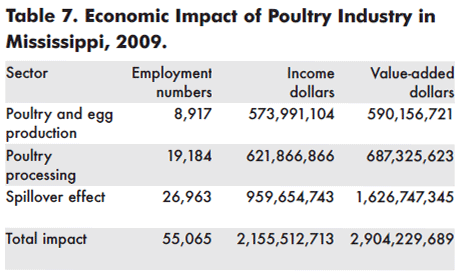
Changes in the economic activity of any one
industry will result in changes throughout the whole
economy. These ‘spill–over’ impacts should increase as
economic interdependence increases. If an industry
relies on local inputs and creates local jobs, then the
spill–over impacts within the local economy should be
relatively large. But if the industry relies on imported
inputs, produces commodities that are exported, or is
not very labour–intensive, then the spill–over impacts
would be relatively small.
There are two types of spill–over impacts: indirect
and induced. Indirect impacts reflect the many interindustry
relationships involved in upstream
production processes. Induced impacts are generated
by the extra spending of households stemming from
income generated through direct and indirect impacts
on production.
A concept related to income is value added, which
is defined as a firm’s revenue from selling its products
minus the amount it paid for intermediate goods and
services. For example, say a firm purchases a raw
product for $7 from one ‘upstream’ firm and purchases
inputs for $3 from other ‘upstream’ firms. It uses
other factors of production, such as labour and capital,
to transform the raw product into a finished product,
and then sells the finished product for $15 to a ‘downstream’
buyer. The production activities of this firm
resulted in a value added of $5, which is computed as
$15 less $7 less $3. The firm will then use its value
added ($5) to cover its expenses:
- payments to its factors of production (labour and capital),
- indirect business taxes, and
- profits.
If value added is computed for each firm in every
stage in the supply chain, the total value added
throughout the supply chain will be equal to the sales
value of the final product. The economic impact of the
poultry industry in Mississippi is presented in Table 7.
The Mississippi poultry industry directly employs an
estimated 28,101 people to produce and process broilers
and eggs. Wages and salaries paid to these
employees totaled more than $1.19 billion. Spill–over, or
the economic activity generated in other industries due to the indirect and induced economic effect,
accounted for another estimated 26,963 jobs, with payrolls
of $960 million.
The total direct, indirect and
induced economic impact of the poultry industry in
Mississippi is an estimated 55,065 jobs with $2.1 billion
in income and $2.9 billion in value-added. (Value–added
includes wages and salaries, indirect business
taxes and profits).
Mississippi State Serves the Poultry Industry
- The Department of Poultry Science offers Bachelors
and Masters of Science degrees in several areas of
specialisation. The department also offers a PhD in
agriculture with emphasis in poultry science. The
department conducts research on issues faced by
Mississippi growers and integrators. It regularly
offers workshops to address specific problems affecting
the industry and to keep poultry professionals
current on the latest advances in poultry science.
- The USDA South Central Poultry Research
Laboratory works closely with Mississippi State
University and is providing extremely valuable
information on management inside broiler houses to
improve production. In addition, the laboratory is
providing useful information on environmental
influences on production and has a premier programme
in Mycoplasma research that has the potential to
save the poultry industry millions of dollars in losses
related to this disease.
- The College of Veterinary Medicine conducts
research on diseases affecting poultry flocks and provides
assistance to poultry professionals when
problems arise. They also conduct workshops to
benefit the industry.
- The Department of Food Science, Nutrition, and Health Promotion conducts research to assist the processing sector. They also conduct workshops on food safety and regulatory compliance that benefit the industry.
References
(1) USDA, ERS, Trade and International Markets
Overview 2011
(2) History of Mississippi Poultry Industry. Mississippi State University Extension Service.
Acknowledgements
The authors are grateful to Drs. Kim Morgan and John Michael Riley, Assistant Extension Professors, Department of Agricultural Economics, Mississippi State University, for technical review and comments.
Also, a special thanks to Stan Spurlock, PhD, Professor Emeritus, Department of Agricultural Economics, Mississippi State University, for his contribution to the study.
May 2012







